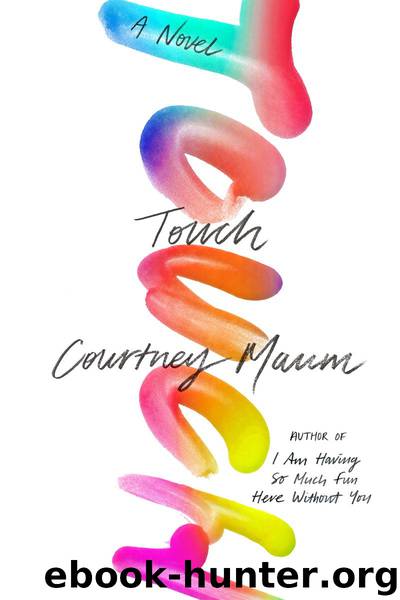Touch by Courtney Maum

Author:Courtney Maum
Language: eng
Format: epub, mobi
Publisher: Penguin Publishing Group
Published: 2017-05-10T14:57:02+00:00
20
Work the next day! What an oafish vessel of a word—employment—when what Sloane had in front of her was an entire future to ignite!
Simple, prolonged intimacy had refueled her instincts. Blissfully, she was awash in the sensations and sharp visions that presaged the understanding of a larger trend. She was back. Granted, many of her premonitions flew in the face of what Mammoth stood for, but she would find a way to tame them into dutiful foot soldiers. What mattered is that she was having ideas again.
On the ride to the office, Sloane’s mind was a veritable flow chart of the way that touch could return to people’s lives. Gardening, handwriting instruction, arm wrestling, tango. Break dancing, harp playing, baking bread from scratch. Second skin. Skin-to-skin. Voluntary skin grafts.
Real, in-person socializing. Face-to-face language lessons. Enlarging of the family by secondary means. Adoption. Youth-mentoring programs. Borrowing grandparents. This was an idea that came to Sloane as Anastasia idled at a stoplight in front of the Eye and Ear Infirmary at 14th Street, where nurse aides were helping their stooped and wheelchaired charges into the hospital, curved hands on their backs.
People were losing connection with their elders: not just in terms of people not making the efforts to stay in touch with their relatives, but also in terms of connecting with them physically: engaging with old people, touching their thin skin. Sloane felt certain that they’d soon be seeing a lot more of the elderly in advertisements. Just look at the success of the Céline campaign that used the octogenarian Joan Didion as a model, or Jin picking up on the same trend in his rejected phone ad. Skin, to a certain extent, is the ultimate expression of tactility: it changes its appearance and integrity every day. After decades of seeing people Botoxed and airbrushed in film and magazines, Sloane could envision a celebration of aged skin. The lines, the furrows, the scars, the sculptures that time works into our bodies to hallmark a life lived.
People paid to use strangers’ cars to get to work now, they rented out rooms in other people’s homes. For the moment, the sharing economy was mostly about things, but if Sloane stretched into the void where possibility lapped, she could see an economy where people would share people. An expansion of services in professional touch (and not, as Dax simplified, simply more prostitution). Craniosacral massage, Reiki, laughter therapy, even pedicures, such professionalized forms of tenderness were already common. But the outsourcing would become more extreme, more existential. Sloane thought about the idea she blurted out at the Sparkhouse meeting: a world in which people rented friends and relatives. If they didn’t have a sibling, they could sign up for a brother or a sister from a list of volunteers. No children? Part-time foster parenthood, a rise in foreign exchange student sponsorships, a national registry for therapy babies: all of these could trend.
Several years earlier, a rival Dutch trend forecaster had posited altruism as a rising movement, but Sloane never thought that this rang right.
Download
This site does not store any files on its server. We only index and link to content provided by other sites. Please contact the content providers to delete copyright contents if any and email us, we'll remove relevant links or contents immediately.
The Hating Game by Sally Thorne(18736)
Cat's cradle by Kurt Vonnegut(14768)
The Break by Marian Keyes(9084)
Crazy Rich Asians by Kevin Kwan(8894)
A Man Called Ove: A Novel by Fredrik Backman(8200)
Me Before You by Jojo Moyes(6255)
The Rosie Project by Graeme Simsion(5845)
Beartown by Fredrik Backman(5369)
Eleanor Oliphant Is Completely Fine by Gail Honeyman(5087)
A Year in the Merde by Stephen Clarke(5080)
Beach Read by Emily Henry(5005)
The Unhoneymooners by Christina Lauren(4663)
Audition by Ryu Murakami(4622)
China Rich Girlfriend by Kwan Kevin(4296)
Rich People Problems by Kevin Kwan(4128)
Ayesha At Last by Uzma Jalaluddin(4001)
Lamb, the Gospel According to Biff by Christopher Moore(3301)
Hardcore Twenty-Four by Janet Evanovich(3234)
The Rosie Effect by Graeme Simsion(3214)
